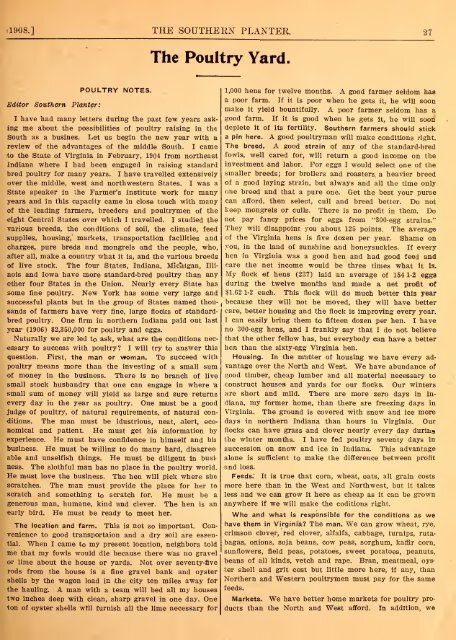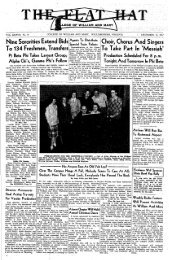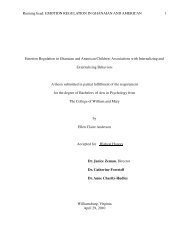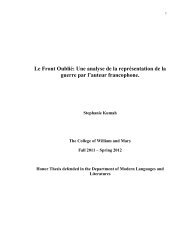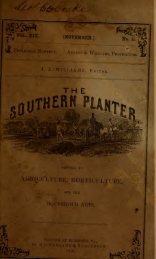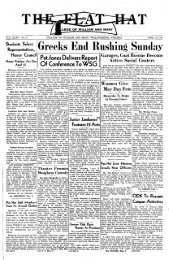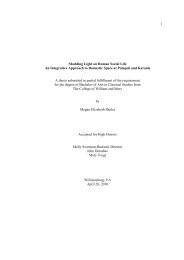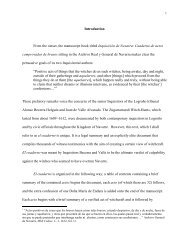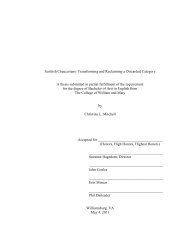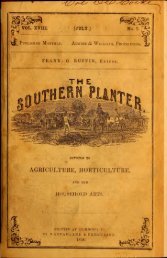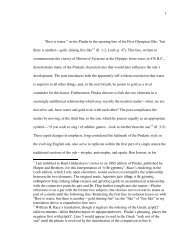Southern planter - The W&M Digital Archive
Southern planter - The W&M Digital Archive
Southern planter - The W&M Digital Archive
Create successful ePaper yourself
Turn your PDF publications into a flip-book with our unique Google optimized e-Paper software.
1908.] THE SOUTHERN PLANTER. 27<br />
Editor <strong>Southern</strong> Planter:<br />
POULTRY NOTES.<br />
I have had many letters during the past few years ask-<br />
ing me about the possibilities of poultry raising in the<br />
South as a busines. Let us begin the new year with a<br />
review of the advantages of the middle South. I came<br />
to the State of Virginia in February, 1904 from northeast<br />
Indiana where I had been engaged in raising standard<br />
bred poultry for many years. I have travelled extensively<br />
over the middle, west and northwestern States. I was a<br />
State speaker in the Farmer's Institute work for many<br />
years and in this capacity came in close touch with many<br />
of the leading farmers, breeders and poultrymen of the<br />
eight Central States over which I travelled. I studied the<br />
various breeds, the conditions of soil, the climate, feed<br />
supplies, housing, markets, transportation facilities and<br />
charges, pure breds land mongrels and the people, who,<br />
after all, make a country what it is, and the various breeds<br />
of live stock. <strong>The</strong> four States, Indiana, Michigan, Illinois<br />
and Iowa have more standard-bred poultry than any<br />
other four States in the Union. Nearly every State has<br />
some fine poultry. New York has some very large and<br />
successful plants but in the group of States named thousands<br />
of farmers have very fine, large flocks of standardbred<br />
poultry. One firm in northern Indiana paid out last<br />
year (1906) $2,350,000 for poultry and eggs.<br />
Naturally we are led to ask, what are the conditions nec-<br />
essary to success with poultry? I will try to answer this<br />
question. First, the man or woman. To succeed with<br />
poultry means more than the investing of a small sum<br />
of money in the business. <strong>The</strong>re is no branch of live<br />
small stock husbandry that one can engage in where a<br />
small sum of money will yield as large and sure returns<br />
every day in the year as poultry. One mlust be a good<br />
judge of poultry, of natural requirements, of natural con-<br />
ditions. <strong>The</strong> man must be idustrious, neat, alert, economical<br />
and patient. He must get his information by<br />
experience. He must have confidence in himself and his<br />
business. He must be willing to do many hard, disagree<br />
able and unselfish things. He must be diligent in busi-<br />
ness. <strong>The</strong> slothful man has no place in the poultry world.<br />
He must love the business. <strong>The</strong> hen will pick where she<br />
scratches. <strong>The</strong> man must provide the place for her to<br />
scratch and something to scratch for. He must be a<br />
generous man, humane, kind and clever. <strong>The</strong> hen is an<br />
early bird. He must be ready to meet her.<br />
<strong>The</strong> location and farm. This is not so important. Convenience<br />
to good transportaion and a dry soil are essen-<br />
tial. When I came to my present location, neighbors told<br />
me that my fowls would die because there was no gravel<br />
or lime about the house or yards. Not over seventy-five<br />
rods from the house is a fine gravel bank and oyster<br />
shells by the wagon load in the city ten miles away for<br />
the hauling. A man with a team will bed all my houses<br />
two inches deep with clean, sharp gravel in one day. One<br />
ton of oyster shells will furnish all the lime necessary for<br />
<strong>The</strong> Poultry Yard.<br />
i<br />
1,000 hens for twelve months. A good farmer seldom has<br />
a poor farm. If it is poor when he gets it, he will soon<br />
make it yield bountifully. A poor farmer seldom has a<br />
good farm. If it is good when he gets it, he will soon<br />
deplete it of its fertility. <strong>Southern</strong> farmers should stick<br />
a pin here. A good poultryman will make conditions right.<br />
<strong>The</strong> breed. A good strain of any of the standard-bred<br />
fowls, well cared for, will return a good income on the<br />
investment and labor. For eggs I would select one of the<br />
smaller breeds; for broilers and roasters a heavier breed<br />
of a good laying strain, but always and all the time only<br />
one breed and that a pure one. Get the best your purse<br />
can afford, then select, cull and breed better. Do not<br />
keep mongrels or culls. <strong>The</strong>re is no profit in them. Do<br />
not pay fancy prices for eggs from "300-egg strains."<br />
<strong>The</strong>y will disappoint you about 125 points. <strong>The</strong> average<br />
of the Virginia hens is five dozen per year. Shame on<br />
you, in the land of sunshine and honeysuckles. If every<br />
hen in Virginia was a good hen and had good feed and<br />
care the<br />
My flock<br />
net income would<br />
of hens (237) laid<br />
be three times what it Is.<br />
an average of 154 1-2 eggs<br />
during the twelve months land made a net profit of<br />
$1.62 1-2 each. This flock will do much better this year<br />
because they will not be moved, they will have better<br />
care, better housing and the flock is improving every year.<br />
I can easily bring them to fifteen dozen per hen. I have<br />
no 300-egg hens, and I frankly say that I do not believe<br />
that the other fellow has, but everybody can have a better<br />
hen than the sixty-egg Virginia hen.<br />
Housing. In the matter of housing we have every advantage<br />
over the North and West. We have abundance of<br />
good timber, cheap lumber and all material necessary to<br />
construct houses) and yards for our flocks. Our winters<br />
are short and mild. <strong>The</strong>re are more zero days in In-<br />
diana, my former home, than there are freezing days in<br />
Virginia. <strong>The</strong> ground is covered with snow and ice more<br />
days in northern Indiana than hours in Virginia. Our<br />
flocks can have grass and clover nearly every day durina<br />
the winter months. I have fed poultry seventy days in<br />
succession on snow and ice in Indiana. This advantage<br />
alone is sufficient to make the difference between profit<br />
and loss.<br />
Feeds. It is true that corn, wheat, oats, all grain costs<br />
more here than in the West and Northwest, but it takes<br />
less and we can grow it here as cheap as it can be grown<br />
anywhere if we will make the coditions right.<br />
Who and what is responsible for the conditions as we<br />
have them in Virginia? <strong>The</strong> man. We can grow wheat, rye,<br />
crimson clover, red clover, alfalfa, cabbage, turnips, ruta-<br />
bagas, onions, soja beans, cow peas, sorghum, kaffir corn,<br />
sunflowers, field peas, potatoes, sweet potatoes, peanuts,<br />
beans of all kinds, vetch and rape. Bran, meatmeal, oyster<br />
shell and grit cost but little more here, if any, than<br />
Northern and Western poultrymen must pay for the same<br />
feeds.<br />
Markets. We have better home markets for poultry products<br />
than the North and West afford. In addition, we


